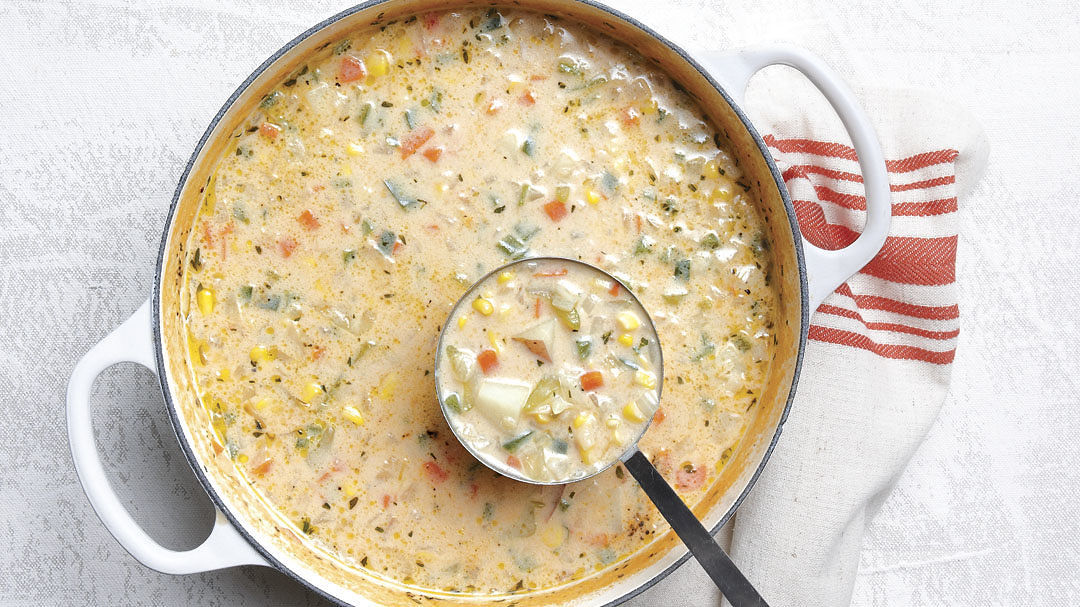RE-ENVISION: Chowder
RE-ENVISION is an ongoing series of research memos produced by our associates at Appetite. We trace the cultural genealogies of food from around the world to challenge commonly held beliefs about origin and authenticity.
In our exploration of stews around the world, we noticed a universal preference for fat, fish, and water mixtures.
In the Benedictine monasteries of 12th century Germany, Hildegard of Bingen created a potent cure for skin ailments by mixing whale brain and water, boiled and mashed with goutweed and oil.1 While not a part of the origin story of chowder, Hildegard’s concoction was a powerful testament to the potential of a simple seafood mixture.2 Enter the chowder.
New England Clam Chowder, chowder’s most famous form, is simple: clams, pork, and a creamy milk broth. Unsurprisingly, what’s known as a New England tradition is not an American creation. Chowder was first conceptualised in the English channel-side town of Cornwall in Southwest England and the region of Brittany in Northwest France in the mid-fifteenth century.3 Villagers set up chaudieres, or cauldrons, of hot water in which fishermen returning from the English channel dumped their offal.4 It was this concept that the pilgrims— those who rejected the Church of England— of Scrooby, Nottinghamshire, brought to the New World in 1620 when they fled religious persecution under James I, who had declared that rejecting the Church was illegal.5
Not only was the origin of chowder founded upon the movement of people. Its evolution, too, was largely powered by foreign influences entering the United States. The pilgrims, coming from an inland village with no easy access to the sea, initially expressed a liking for freshwater seafood, such as eel.6 Post-migration, the presence of saltwater ingredients along the New England coast offered a plethora of new subjects to experiment with in their continued exploration of mixing fat, fish, and water.7 This led to the addition of a crucial ingredient of New England clam chowder — the quahog, a type of clam.8
Over time, the influx of immigrants resulted in new versions of the chowder, much to the consternation of New Englanders.9 Manhattan clam chowder, which is known for its addition of tomatoes, was conceptualised by Italian immigrants in New York and the Portuguese fishing communities of Rhode Island. It was created by Alessandro Filippini and Charles Ranhofer, who worked at Delmonico’s Restaurant in New York from 1849 to 1863 and 1962 to 1896 respectively.10 They codified as “Chowder de Lucines” 11 to pay homage to the Portuguese settlers who had brought the recipe to New England when they arrived in the late 1700s. They had prepared a chowder that included tomatoes and pickled fish, an ingredient popular with Portuguese fishermen.12 The arrival of the British from British India (with their indentured servants) brought spices such as curry powder (which comprised crushed coriander, turmeric, cumin, and chilli peppers) to the dish.13 Their subsequent expansion into Bermuda brought tomato based chowder to its cuisine; today’s Bermuda Tomato Chowder is the national dish of Bermuda, and is an appropriation of the Manhattan clam chowder.14
Close analogues of the chowder include the pozole, a Mesoamerican dish which, until the Spanish outlawed it, was made with the human meat of those given for human sacrifice; and gumbo, a New Orleans staple that includes shellfish, bacon fat, and tomatoes.
Annotated Bibliography
Walker and Cox, “A History of Chowder: Four Centuries of a New England Meal”, 2011. Link: https://bit.ly/2QSPT1Z
Both Robert Cox and Jacob Walker are food writers and historians who write extensively on Chowder and other foods native to or important to Massachusettes. They have also teamed up to write “Massachusetts Cranberry Culture: A History from Bog to Table”.
Linda Stradley, What’s Cooking America. https://whatscookingamerica.net/History/ChowderHistory.htm
What’s Cooking America is run by homecook Linda Stradley, who has always “had a fascination with history”, specifically food history. The site has an average of approximately a million users a month and 26 million users annually. It has been featured on a variety of reputed news and cable channels, including NPR, Eater, and the Smithsonian.
Cynthia Correa, 2016. “A Brief History of Clam Chowder”.Source: https://www.eater.com/2016/1/31/10810568/clam-chowder-manhattan-hatteras-new-england-rhode-island-minorcan-new-jersey
Cynthia Correa is a contributor to Eater, a food and dining network of sites under Vox Media. It serves as a local restaurant guide as well as a food and drink lifestyle website. Eater currently hosts 23 sites across the United States and Canada, and in mid-2017 launched its first London site.
White, 1998. “Lobster at Home”. Source: https://bit.ly/2OPgURf
Jasper White is a chef, restaurateur and cookbook author who is recognised as one of the leading authorities on New England food and its history, in particular seafood. He is currently the owner of three Summer Shacks – replicas of roadside New England clam shacks that serve “no-frills, high quality seafood” – across New England.
Written by Arjun Jayaraman.
Notes
1 Walker and Cox, “A History of Chowder: Four Centuries of a New England Meal”, 2011. Link: https://bit.ly/2QSPT1Z
2 Ibid.
3 Hooker, “The Book of Chowder”, 1978. Link: https://bit.ly/37IWtOM
4 Source: https://whatscookingamerica.net/History/ChowderHistory.htm
5 Plimoth Plantation. Source: https://www.plimoth.org/learn/just-kids/homework-help/who-were-pilgrims
6 Root and De Rochemont, 1976. “Eating in America: A History”. Source: https://whatscookingamerica.net/History/ChowderHistory.htm
7 Ranahan, 2018. “Why New England ‘chowdah’ reigns supreme in the clam chowder rivalry”. Source: https://www.10best.com/interests/food-travel/why-new-england-chowda-reigns-supreme-in-the-clam-chowder-rivalry/
8 Ibid.
9 Correa, 2016. “A Brief History of Clam Chowder”. Source: https://www.eater.com/2016/1/31/10810568/clam-chowder-manhattan-hatteras-new-england-rhode-island-minorcan-new-jersey
10 Source: https://whatscookingamerica.net/History/Chowder/ManhattanChowder.htm
11 Ibid.
12 White, 1998. “Lobster at Home”. Source: https://bit.ly/2OPgURf
13 Sen, 2009. “Curry: A Global History”. Source: https://www.atlasobscura.com/articles/what-is-curry-powder
14 Link: https://whatscookingamerica.net/History/Chowder/BermudaFishChowder.htm

